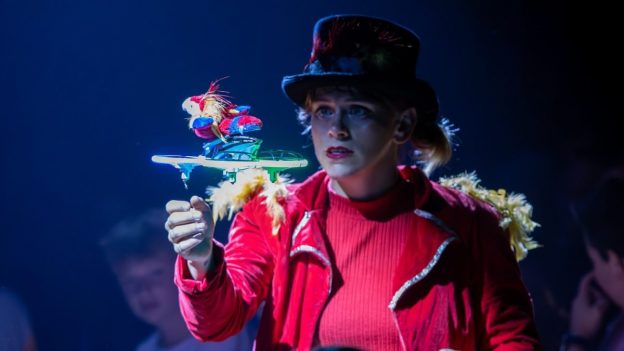A ghost house, a Wheel of Death, a pack of wolves, and a 17-strong ensemble of acrobats from 13 different countries. Four circus shows seen at the Edinburgh Festival Fringe 2025 by Dorothy Max Prior
Circus Hub on the Meadows is always the first port of call for anyone attending the Edinburgh Festival Fringe with a yen for world-class circus; and for 2025 they are back with a programme of 11 shows – not only circus but also cabaret, comedy, and variety – presented in their two venues, the Lafayette Big Top and Beauty Spiegeltent.
This year, I saw three shows on the programme, all strictly circus, and all in Lafayette.
Québec’s Flip Fabrique bring us Six° – a show previously presented online for the Edinburgh Fringe 2021, that odd Covid-ish year when the Fringe returned, but in a reduced hybrid form, with much online. I gave that a miss then, so was very pleased to see it back for real.
It starts with the sound of a thunderstorm, the rain lashing down. Which is ironic as the performance I’d originally been booked in to see the day before had been cancelled due to the massive storms, with 85mph winds sweeping Scotland, and making shows in a circus tent out of the question. So some of us are looking up anxiously – but no, it’s definitely on the soundtrack, not for real. ‘Storms make the flowers fresh again’ we are told.
This is an ensemble show with a cast of five – six if we include the house in which the action takes place, which most definitely has a personality of its own: talking to the occupants, issuing instructions, and sometimes taking the electronic controls into its own hands. There have been numerous sci-fi stories about houses that are seemingly alive, often malevolent, and Ray Bradbury’s HappyLife Home (in short story The Veld) comes to mind at a point in the narrative when a door opens to reveal a red-lit space animated by the roar of lions.
I say ‘narrative’ but this one is very much of the fractured variety. We meet five different occupants, who it would seem have received a mysterious invitation that leads them, on a stormy night, to an old abandoned building deep in the forest. But the house doesn’t look deserted; it is cosily furnished and seems to have a soul. Oddly, the five seem be in residence at different times, or perhaps in different multiverse strands – one in the 1950s, one the 1970s, one the 1990s etc. They are all there, but rarely seem to see each other: to each, the others are more like ghosts than real flesh-and-blood people.
As for the set: the ‘house’ is a three-walled structure that is tugged around into different permutations throughout the show. There are doors and windows and picture frames and tables and bookshelves – all of which are animated throughout the piece. Frames get pulled off to be used as hoops; a small table become the site for a balancing act; book leaves fly around the space. There’s most definitely an Alice in Wonderland vibe: not least because one of the female performers is dressed in a puff-sleeved frock, Mary-Jane shoes and a large satin hair bow.
We are given scenes of everyday at-home life that take on a surreal dream-like quality – a way of bringing the circus acts in to the equation. Often, one person is presenting their act – Robert with his deft book/brick-juggling, say – whilst others are interacting with him more as witnesses or silent partners than as co-performers. It’s an interesting dynamic. As far as the circus acts go, we get top-notch juggling, smoothly sensuous hooping, a great female Cyr wheel turn, a lovely two-man acrobalance and tumbling routine, and of course – this is Flip Fabrique, after all – some fantastic trampolining by the boys that’s nicely merged with a female hand-balancing and contortion act, performed on the ‘roof’ of the house. Sonically, there’s a palate of recognisable pre-existing tunes driving the piece forward. We veer from Harry Nilsson’s cheery ‘Coconut’ to Leonard Cohen’s gloriously moving ‘Happens to the Heart’ and on to The Commodores anthemic ‘Brick House’.
It is no surprise that the show was made during Covid – addressing how we deal with loneliness and isolation, whilst also staying connected to others by remote. It also seems to be portraying the power of the imagination to overcome humdrum realities when stuck indoors. Six° is a very different sort of show to Flip Fabrique’s usual non-stop hi-energy work: slower, more thoughtful, but still thrilling. Most highly recommended!
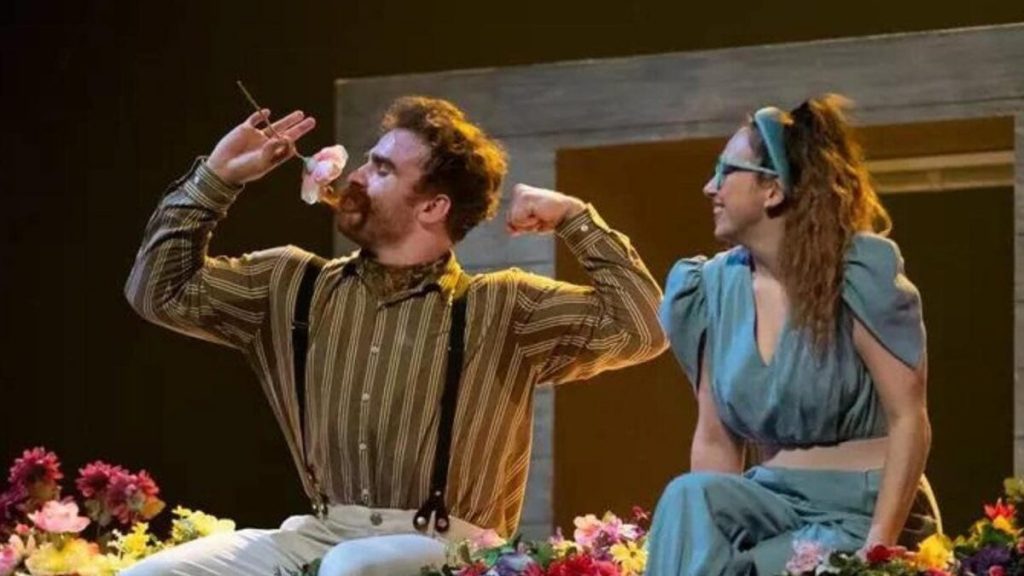
Next up was Nose Dive Assembly, described as ‘big-top circus with heart and spectacle’ from the UK’s Revel Puck Circus. I’d missed this at Brighton Fringe earlier this year, so was glad to catch it in Edinburgh. It’s a hi-energy fun-for-all-the-family spectacle. It’s contemporary circus in its aesthetic – for example, the performers are dressed not in spangly leotards but in unisex jumpsuits or colourfully patterned trousers and shirts – but with much of the structure and good-time vibe of a traditional tented circus.
That trad structure and vibe is clear in the show’s use of the clown as the communicator with the audience; the person who reminds us with their actions that acrobats are fallible human creatures. The clown also traditionally keeps the audience entertained whilst the riggers and stagehands (or, as is the case in contemporary circus, the other performers) move the kit in to place for the next act. Most of the cast are British trained (I learn from the legendary Charlie Holland that seven are graduates from the National Centre for Circus Arts, aka Circus Space) – with Canadian clown and acrobat Arielle Lauzon the exception.
Although traditional in function, the fabulous Arielle Lauzon is very much of the contemporary world: a former competitive gymnast who trained at the École de Cirque de Québec. She appears first at the rear of the big top, harnessed and desperate to fly ‘on the wings of a butterfly’. This becomes a thread developed throughout the show – at one point moving through us with a ludicrous contraption of electric fans strapped to her body that she hopes will help her take off; at another point, sporting a giant balloon that covers her whole head. (I’m one of numerous audience members roped in to pump up the balloon.) Eventually, towards the end of the show, she makes do with a butterfly costume and gives us a spectacular mat-based acrobatics routine, proving that she is more than a funny face.
After Arielle’s entrance, we go to Annie Zita on the cloudswing – a fabulously thrilling opening act. The show whizzes by, with many traditional favourites given a contemporary twist, including a great aerial straps act from Imani Vital (I love the performer’s oddly flexed feet, and the moment when she holds hands with her counter-balancer). We get a neat hand-balancing turn from Becky Robins, and a great teeterboard act from Sebastian Parker and Emily Lannigan, to the tune of the Rolling Stones’ ‘Sympathy for the Devil’. There’s also the much-touted Revel Puck USP: a circular stage that rises, with Thorne Bailey and Fiona Thornhill presenting a skilfully synchronised Cyr Wheel routine. Bailey is raised into the air on the platform, whilst Thornhill spins below, the lighting design highlighting each performer in turn. Later, they switch roles, so she is now on the raised platform, and he is below. This is one of numerous shows I see at this year’s Fringe that feature a female Cyr wheel performer: something that used to be a rare occurrence. The times they are a-changing.
The final act of the show sees Fiona Thornhill and Emily Lannigan back, this time on the Wheel of Death, that most traditional of circus acts, although this is the only one in the UK (perhaps in the world, I don’t know!) that is performed by two women. If you don’t know what this is, imagine two giant hamster wheels on a pivoting metal structure, one performer inside each wheel, walking then twisting and turning as the wheel turns at a faster and faster pace, reversing direction now and then. The choice of music – Laurie Anderson’s ‘O Superman’ – is great. The mesmeric, repetitive loop of the song suits the act perfectly. The complicity between the performers, the timing and the sensitive response to the music makes this act more than a traditional circus spectacle. It’s a great finale to a lovely show that is daring, funny, and totally entertaining. Bravo Revel Puck – it feels that British circus is flying off with flair into new dizzying heights, occupying territories previously claimed by the traditional tented circus companies, and infusing them with a funky feminist vibe.
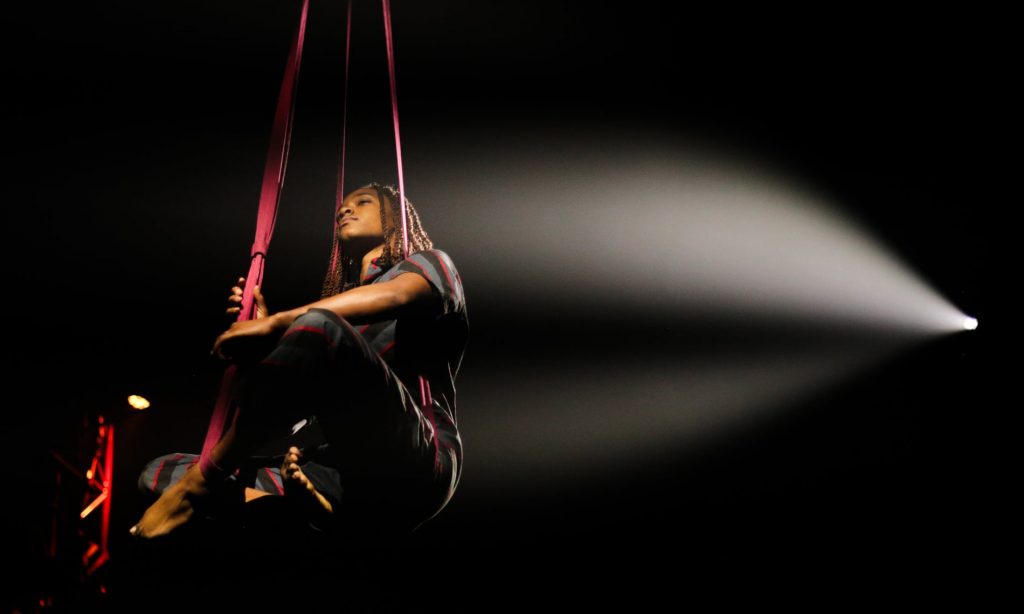
Finally, Circa: Wolf is my third show of the day at the Circus Hub, again in the Lafayette big top tent – although this is a predominantly floor-based acrobatic show, so height is rarely needed.
Hardly surprising with Wolf as the title, the show features a lot of hunting and stalking movements; and a lot of pack work. Dressed in sleek, tight-fitting black and fawn costumes (designed by Libby McDonnell), the ten-strong company arrive on stage with a ferocious energy, within minutes creating three-high towers or staggering stacks of six people on one base. The pack runs in circles, spreads out into straight lines, huddles in big or small groups – with a breathtaking move from one complex acrobalance or hand-to-hand tableau to another, human towers rising and falling (often sideways, which is terrifying), people swung or thrown to other people; and links of fast-paced solo acrobatics into and out of position.
At one point the group moves into a capoeira-style roda or inward facing circle, different partnerships of men with men, men with women, and women with women, playing out battles to be leader of the wolf pack. This being Circa, female bases are a given – the women here are strong and fierce. There’s a lovely scene where the wolf theme seems to be taken into the domain of the gay male nightclub; an all-male tussle for intimacy and the role of top dog.
There are just two breaks in the ferociously fast floor action, one for a female aerial straps performer who acts out what seems to be a twisted marionette motif, although perhaps it is intended as a captured animal. But this is me constructing narrative: it is robotic and staccato, and feels quite different in tone to the rest of the show. There’s also a male rope act – like the straps act, top-notch of course (there wouldn’t be anything less in a Circa show) but again I can’t quite decide if it is really needed. Perhaps if everything were floor-based I might be craving something else, but both times the arrival of aerial equipment feels slightly out of kilter.
As for the scenography and sound design: Circa have commissioned a hardcore techno score for Wolf from DJ Ori Lichtik. And it is pretty relentless! At times the bass really works its way into your guts, adding to the edginess of the piece. There is no set, and no equipment other than the aforementioned aerial straps and corde lisse rope. The lighting design gives us scenes lit with a tooth-and-claw blood red, and an eery jungle green. There is sometimes smoke haze. But the main impression is of a tabula rasa, on which director Yaron Lifschitz has written a thrilling physical story – animal magic meets stupendous human achievement. As ever, Circa are the crowing glory of the Circus Hub programme.
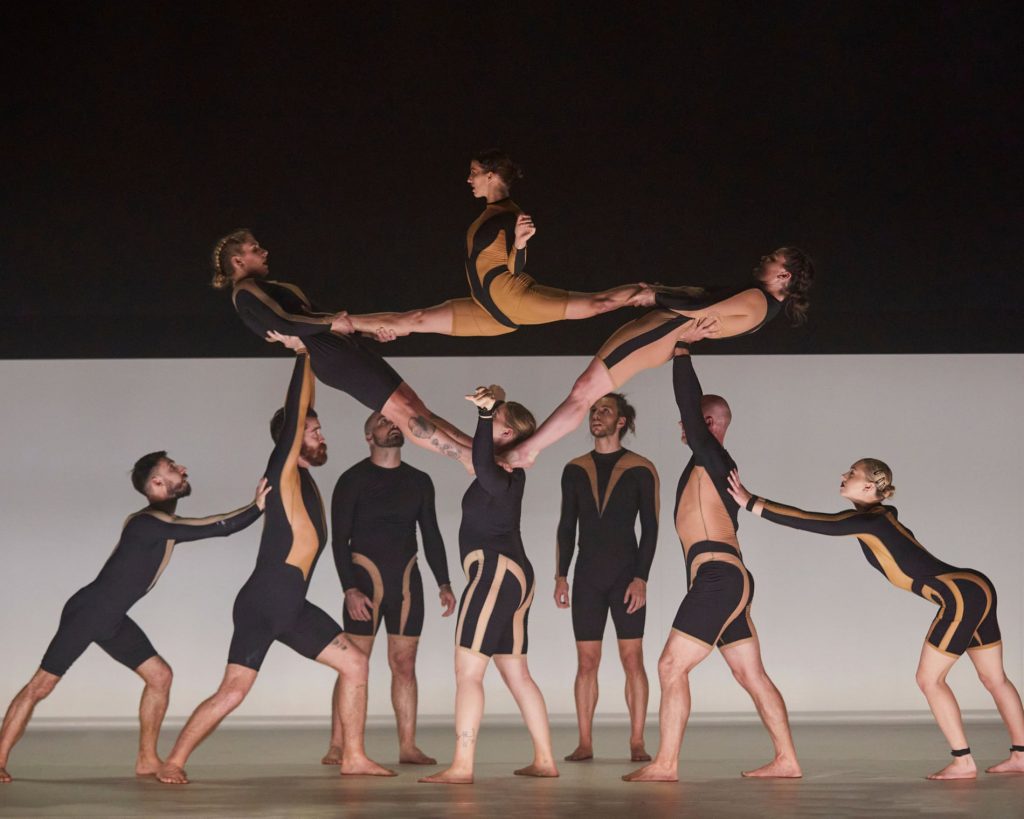
Away from The Meadows and over at the grandiose indoor venue Assembly at the Mound, we find The Genesis from Copenhagen Collective – a 17-strong ensemble based in Scandinavia but drawn from all over the world, with artists from Denmark, Australia, Peru, Canada, UK, Uruguay, Chile, Portugal, USA, Germany, Ireland, France and Guinea. Phew, that is indeed an international line-up!
There are many crossovers with Circa, and I think it would be fair to say that without Circa, The Genesis (and very many other contemporary circus shows) would never have existed. Dressed like gymnasts, not entertainers, in unisex dark lycra? Check. Amazing ensemble skills, with phenomenal complicity, super-precise timing, and a breathtaking move from one ‘picture’ to another? Check. Female strength and power highlighted, with women bases the norm throughout the show rather than the exception? Check. This is no criticism: the Copenhagen Collective are a newly-formed ensemble, and Circa have been going for 20-plus years. I remember seeing Circa’s first appearance at the Edinburgh Fringe, and like everyone else was astonished at witnessing the role that the women performers played, the focus on power not prettiness. We hadn’t seen anything like it! Two decades on, this is routine in much contemporary circus worldwide – younger artists probably think nothing of it. Which can only be a good thing.
The Genesis, like Circa’s Wolf, is less a narrative show than a themed show, and on similar territory. We seem to be witnessing the exploration of the human soul versus the animal spirit. It is purely floor-based: there is no aerial or other non-acrobatic acts. No equipment, no set. Everything is down to the human body – and mostly the 17-strong ensemble are all on stage at once, morphing from one extraordinary grouping to another. Thus, we have at one point early in the show a five triple towers, which makes for a fantastic stage image. There’s a lot of hero-and-chorus work – solo performers emerging from circles or huddles. I love the strange tower of bodies that grows from a heap on the floor, people standing on the shoulders or chests of others. There’s a fabulous ‘resurrection’ scene where 16 bodies are lying prone on the floor and one person animates them by tugging on a body part, each revived person going on to revive another. There’s also a great party scene, with waves of performers progressing forward in different combos, vogueing and reaching out to the audience – one of the few points when the fourth wall is broken. Another occurs when a lone man is thrown out of an upstage huddle of bodies, rights himself, and says ‘hi’ to us slightly sheepishly. I enjoy these theatrical moments – the first half of the piece is full of fabulously skilled acrobatics, but rather dense in its relentless onslaught of astonishing tricks and turns, with towers rising and falling, three- or four- or five-way acrobalance ‘sculptures’ developing and dissolving – but with a feeling that the performers are behind a glass wall. When that wall is shattered, the show becomes stronger.
The stage set-up is simple – looking quite a bit like a school gymnasium, in fact. The lighting is minimal, mostly blue and white; and the music a good mix, interspersing relentlessly beat-driven scenes with more moody string sections, and including a few pre-recorded autobiographical-confessional texts about control and vulnerability, reminding me of Les 7 Doigts’ show Traces. So yes – echoes of other company’s work – but it’s own thing too. What is most extraordinary is to see so many fabulously skilled human bodies working together so harmoniously. And really – how often do you see a four-high tower? As they take their bow, the full house at the Mound go wild in their appreciation. It’s not my favourite Fringe circus show this year, but it is one of the best – predictably, a sure-fire hit.
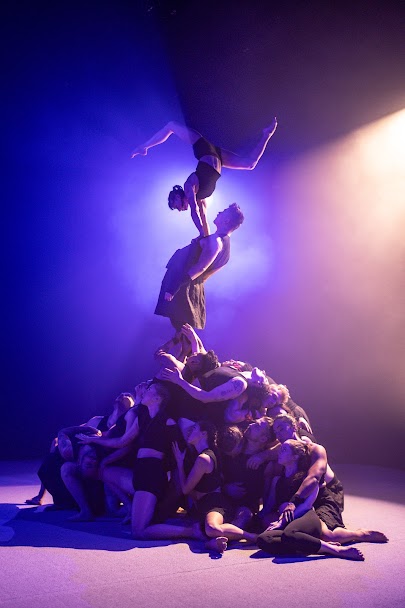
Featured image (top): Revel Puck Circus: Nose Dive Assembly
Flip Fabrique: Six°, Underbelly’s Circus Hub on the Meadows (The Lafayette), 14:05
Revel Puck Circus: Nose Dive Assembly, Underbelly’s Circus Hub on the Meadows (The Lafayette) | 16:10
Circa:Wolf, Underbelly’s Circus Hub on the Meadows (The Lafayette), 18:20
Copenhagen Collective: The Genesis, Assembly at the Mound, 12:30
For more information or to book tickets, see www.edfringe.com

